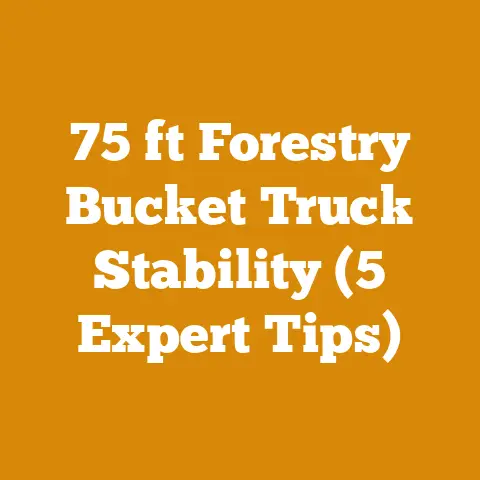Tree Cutting License Insights (5 Pro Tips for Wood Processors)
What if you could unlock the full potential of your wood processing operation, transforming it from a labor-intensive chore into a streamlined, efficient, and even profitable endeavor? It all starts with understanding the often-overlooked foundation: the tree cutting license. Many see it as a mere formality, a piece of paper standing between them and the satisfying crack of a falling tree. But trust me, after years of experience in logging, wood processing, and firewood preparation, I’ve learned that a tree cutting license is your gateway to responsible, sustainable, and ultimately, more profitable wood management.
In this guide, I’m going to share five pro tips, gleaned from my own experiences and observations, that will help you navigate the world of tree cutting licenses. These aren’t just about complying with regulations; they’re about maximizing your efficiency, minimizing your risks, and ensuring the long-term health of your woodlot. Let’s dive in.
Tree Cutting License Insights: 5 Pro Tips for Wood Processors
1. Understand Your Local Regulations: The Foundation of Legal and Sustainable Wood Processing
The first, and arguably most crucial, step is to thoroughly understand the tree cutting regulations in your specific area. This goes far beyond simply knowing that you need a license. Laws vary dramatically from region to region, even within the same country. Ignorance is not bliss; it’s a recipe for fines, legal battles, and irreparable damage to your reputation.
Why is this so important?
- Legality: Obvious, but worth stating. Operating without the proper license or violating regulations can lead to hefty fines, equipment seizure, and even criminal charges.
- Sustainability: Regulations are often in place to protect forests from over-harvesting, prevent soil erosion, and maintain biodiversity. By understanding and adhering to these rules, you’re contributing to the long-term health of your woodlot and the environment.
- Liability: If you cut down a tree that you’re not supposed to, or if your actions cause damage to neighboring properties, you could be held liable for significant damages.
- Insurance: Many insurance policies for logging and wood processing operations require proof of compliance with local regulations.
How to get started:
- Contact your local forestry department: This is your primary resource. They can provide you with the most up-to-date information on tree cutting regulations, licensing requirements, and best practices.
- Visit your county or municipal government website: Many local governments have online resources dedicated to forestry and land management.
- Consult with a forestry consultant: A qualified forestry consultant can provide expert advice on navigating the regulatory landscape and developing a sustainable wood management plan.
- Attend local workshops and seminars: Many forestry organizations offer workshops and seminars on tree cutting regulations and best practices.
Key questions to ask:
- What types of trees require a license to cut?
- What are the size restrictions for tree cutting (e.g., diameter at breast height – DBH)?
- Are there any protected species or areas that I need to be aware of?
- What are the specific requirements for obtaining a tree cutting license?
- How long is the license valid for?
- What are the penalties for violating the regulations?
- Are there any specific requirements for replanting or reforestation?
- What are the regulations regarding timber transport and sale?
My personal experience:
Early in my career, I was contracted to clear a small plot of land for a new construction project. I obtained what I thought was the necessary permit, but failed to read the fine print. It turned out that the permit only allowed me to cut trees within the building footprint, not the entire plot. I ended up cutting several trees outside the designated area, resulting in a substantial fine and a stern warning from the local forestry department. This taught me a valuable lesson about the importance of thoroughness and attention to detail when dealing with tree cutting regulations.
Case Study: The Impact of Local Regulations on Harvesting Practices
In one region I worked in, the regulations stipulated a selective harvesting approach, meaning only a certain percentage of trees could be removed from a given area within a specific timeframe. This was designed to maintain forest cover and prevent soil erosion. Initially, this seemed like a constraint. However, by carefully planning the harvest and focusing on removing diseased or poorly formed trees, we were able to improve the overall health and productivity of the forest, while still generating a sustainable income. This highlights how regulations, when properly understood and implemented, can actually lead to better long-term outcomes.
2. Master Tree Identification: Knowing Your Trees is Knowing Your Business
Tree identification is more than just a fun skill; it’s a fundamental requirement for responsible wood processing. Different tree species have different properties, values, and regulations surrounding their harvesting. Misidentifying a tree can lead to costly mistakes, legal problems, and even safety hazards.
Why is accurate tree identification crucial?
- Regulatory Compliance: Some tree species may be protected or require special permits to harvest. Knowing your trees ensures you’re not accidentally violating any regulations.
- Wood Quality and Value: Different tree species have different properties that make them suitable for different purposes. Identifying the species allows you to accurately assess the value of the timber and market it accordingly. For example, oak is prized for its strength and durability, making it ideal for furniture and flooring, while pine is softer and more suitable for construction and paper production.
- Processing Techniques: Different tree species require different processing techniques. For example, some woods are easier to split than others, and some require special drying methods to prevent warping or cracking.
- Safety: Some tree species are more prone to certain types of decay or structural weaknesses. Identifying these trees allows you to take appropriate safety precautions during felling and processing.
How to improve your tree identification skills:
- Use a field guide: Invest in a good field guide to the trees of your region. These guides typically include detailed descriptions, illustrations, and photographs of different tree species.
- Take a tree identification course: Many forestry organizations and community colleges offer courses on tree identification.
- Practice in the field: The best way to learn tree identification is to get out into the woods and practice. Start with common species and gradually expand your knowledge.
- Learn from experienced professionals: Spend time with experienced foresters or loggers and ask them to share their knowledge.
- Use online resources: There are many online resources available to help you identify trees, including websites, apps, and online communities.
Key characteristics to look for:
- Leaves: Shape, size, arrangement, and margin (edge) of the leaves.
- Bark: Color, texture, and pattern of the bark.
- Twigs: Color, texture, and arrangement of the twigs.
- Buds: Shape, size, and color of the buds.
- Fruit: Type of fruit (e.g., acorns, cones, berries) and its characteristics.
- Overall shape and form: General shape and size of the tree.
Example:
Let’s say you’re looking at a tree with opposite branching, simple leaves with 5 lobes, and sharp points. The bark is gray and relatively smooth on younger trees, becoming furrowed with age. The tree produces winged seeds (samaras) in clusters. This is likely a maple tree, specifically a red maple (Acer rubrum) or a sugar maple (Acer saccharum). Further examination of the leaf shape and bark characteristics would help you differentiate between the two.
Case Study: Maximizing Value Through Species-Specific Processing
On one project, I was tasked with clearing a mixed hardwood forest. Initially, the plan was to process all the timber into firewood. However, after carefully identifying the tree species, I realized that there was a significant amount of black walnut (Juglans nigra) present. Black walnut is a highly valuable hardwood prized for its beautiful grain and durability. Instead of processing it into firewood, I contacted a local furniture maker who was willing to pay a premium price for the logs. This simple act of tree identification resulted in a significant increase in the overall value of the project.
Data and Insights:
According to the USDA Forest Service, the value of standing timber can vary dramatically depending on the species. For example, in some regions, black walnut can fetch prices 5-10 times higher than that of common firewood species like oak or maple. This underscores the importance of accurate tree identification for maximizing profitability.
3. Develop a Sustainable Harvesting Plan: Long-Term Thinking for Long-Term Benefits
A sustainable harvesting plan is a roadmap for managing your woodlot in a way that ensures its long-term health and productivity. It’s not just about cutting down trees; it’s about managing the forest as a whole ecosystem.
Why is a sustainable harvesting plan essential?
- Environmental Stewardship: A sustainable harvesting plan helps protect the environment by minimizing soil erosion, maintaining water quality, and preserving biodiversity.
- Long-Term Productivity: By managing your woodlot sustainably, you can ensure that it continues to produce valuable timber for generations to come.
- Regulatory Compliance: Many tree cutting licenses require a sustainable harvesting plan as a condition of approval.
- Economic Benefits: A well-managed woodlot can provide a steady stream of income from timber sales, firewood production, and other forest products.
Key elements of a sustainable harvesting plan:
- Inventory: A detailed inventory of the trees on your property, including species, size, and health.
- Objectives: Clear goals for managing your woodlot, such as maximizing timber production, improving wildlife habitat, or protecting water quality.
- Harvesting Methods: Selection of appropriate harvesting methods that minimize environmental impact and promote forest regeneration. Common methods include:
- Selective Cutting: Removing individual trees or small groups of trees, while leaving the majority of the forest intact.
- Group Selection: Removing small patches of trees to create openings for regeneration.
- Clear Cutting: Removing all trees from a designated area. This method is typically used for even-aged management, where all the trees are the same age.
- Reforestation: Plans for replanting or allowing natural regeneration of trees after harvesting.
- Erosion Control: Measures to prevent soil erosion, such as installing water bars and seeding disturbed areas.
- Wildlife Habitat Management: Practices to enhance wildlife habitat, such as creating brush piles and leaving standing dead trees (snags).
- Monitoring and Evaluation: Regular monitoring of the forest to assess the effectiveness of the harvesting plan and make adjustments as needed.
My experience:
I once worked on a project where the landowner had been clear-cutting his forest for decades, without any regard for sustainability. The result was a degraded forest with poor soil quality, reduced biodiversity, and minimal timber value. I helped him develop a sustainable harvesting plan that focused on selective cutting, reforestation, and erosion control. Over time, the forest began to regenerate, and the landowner was able to harvest timber sustainably while improving the overall health of his woodlot.
Strategic Advantages of Sustainable Harvesting:
- Increased long-term profitability: While initial yields might be lower than clear-cutting, sustainable harvesting ensures a continuous stream of income over time.
- Enhanced property value: A well-managed forest increases the value of your property.
- Improved ecosystem health: Sustainable harvesting promotes biodiversity, improves water quality, and reduces the risk of wildfires.
- Positive public image: Demonstrating a commitment to sustainable forestry enhances your reputation and builds trust with the community.
Case Study: Implementing a Selective Harvesting Strategy
I consulted on a 50-acre woodlot where the owner wanted to generate income while preserving the forest’s aesthetic appeal and wildlife habitat. We implemented a selective harvesting strategy, focusing on removing mature, diseased, or poorly formed trees. We marked the trees to be harvested with paint, ensuring that the remaining trees were well-spaced and had ample sunlight for growth. We also left several standing dead trees (snags) to provide habitat for birds and other wildlife. The result was a healthy, productive forest that continued to provide valuable timber while maintaining its ecological integrity.
Data and Insights:
Studies have shown that selective harvesting can actually lead to higher timber yields in the long run compared to clear-cutting. This is because selective harvesting promotes the growth of high-quality trees and reduces the risk of disease and insect infestations.
4. Prioritize Safety: A Safe Operation is a Successful Operation
Wood processing is inherently dangerous. Chainsaws, axes, log splitters, and heavy machinery all pose significant risks. Prioritizing safety is not just a matter of following regulations; it’s a matter of protecting yourself, your employees, and your property.
Why is safety so important?
- Prevent Injuries: Wood processing accidents can result in serious injuries, including cuts, lacerations, fractures, and even death.
- Reduce Costs: Accidents can lead to lost productivity, medical expenses, and workers’ compensation claims.
- Maintain Morale: A safe work environment improves employee morale and reduces stress.
- Comply with Regulations: Safety regulations are in place to protect workers and the public. Violating these regulations can result in fines and legal penalties.
Key safety practices:
- Personal Protective Equipment (PPE): Always wear appropriate PPE, including:
- Hard hat: To protect your head from falling branches and debris.
- Eye protection: To protect your eyes from flying chips and dust.
- Hearing protection: To protect your ears from the noise of chainsaws and other machinery.
- Gloves: To protect your hands from cuts and abrasions.
- Chainsaw chaps: To protect your legs from chainsaw cuts.
- Steel-toed boots: To protect your feet from falling logs and other hazards.
- Chainsaw Safety:
- Read and understand the chainsaw’s operating manual.
- Inspect the chainsaw before each use to ensure that it is in good working condition.
- Use the chainsaw only for its intended purpose.
- Maintain a firm grip on the chainsaw with both hands.
- Keep your body balanced and avoid reaching or overextending.
- Be aware of the potential for kickback.
- Never cut above shoulder height.
- Shut off the chainsaw before setting it down.
- Felling Techniques:
- Plan your felling operation carefully, taking into account the lean of the tree, the wind direction, and the presence of any obstacles.
- Clear a path around the tree before felling.
- Use proper felling techniques, including making a notch cut and a back cut.
- Warn others in the area before felling the tree.
- Log Splitting Safety:
- Wear appropriate PPE, including eye protection and gloves.
- Use a log splitter that is properly sized for the logs you are splitting.
- Keep your hands clear of the splitting wedge.
- Never split logs that are too large or too knotty.
- Equipment Maintenance:
- Regularly inspect and maintain all equipment, including chainsaws, log splitters, and heavy machinery.
- Follow the manufacturer’s recommendations for maintenance and repairs.
- Keep equipment clean and well-lubricated.
- Training:
- Ensure that all workers are properly trained in the safe operation of equipment and the proper techniques for wood processing.
- Provide regular safety training and refreshers.
- First Aid:
- Keep a well-stocked first aid kit on hand.
- Ensure that someone on site is trained in first aid and CPR.
- Emergency Plan:
- Develop an emergency plan in case of an accident.
- Post emergency contact information in a prominent location.
My experience:
I witnessed a near-fatal accident when a fellow logger failed to wear proper PPE while felling a tree. A branch fell and struck him in the head, knocking him unconscious. He was lucky to survive, but the incident served as a stark reminder of the importance of safety. Since then, I have always made safety my top priority.
Data and Insights:
According to the National Institute for Occupational Safety and Health (NIOSH), logging is one of the most dangerous occupations in the United States. The fatality rate for loggers is significantly higher than the average for all industries. This underscores the critical importance of prioritizing safety in wood processing operations.
5. Maximize Wood Utilization: Reduce Waste, Increase Profits
Wood utilization refers to the efficient use of harvested timber to minimize waste and maximize the value of the resource. It’s about getting the most out of every tree you cut down.
Why is maximizing wood utilization important?
- Economic Benefits: Reducing waste increases the amount of usable timber, which translates into higher profits.
- Environmental Benefits: Maximizing wood utilization reduces the need to harvest more trees, which helps protect forests and reduce carbon emissions.
- Resource Conservation: Efficient wood utilization helps conserve valuable resources for future generations.
Strategies for maximizing wood utilization:
- Careful Planning: Plan your harvesting operation carefully to minimize waste. This includes selecting appropriate harvesting methods, minimizing damage to standing trees, and avoiding unnecessary cutting.
- Accurate Bucking: Bucking refers to cutting logs into specific lengths. Buck logs accurately to maximize the yield of valuable lumber.
- Grade Sawing: Grade sawing involves cutting logs into different grades of lumber based on their quality. This maximizes the value of the timber by ensuring that the highest-quality lumber is used for the most demanding applications.
- Utilize Small Diameter Trees: Small diameter trees can be used for a variety of purposes, including firewood, pulpwood, and small-dimension lumber.
- Process Wood Waste: Wood waste, such as sawdust, bark, and wood chips, can be processed into valuable products, such as mulch, compost, and fuel pellets.
- Kiln Drying: Kiln drying reduces the moisture content of lumber, making it more stable and less prone to warping or cracking. This increases the value of the lumber and reduces waste.
- Proper Storage: Store logs and lumber properly to prevent decay and insect infestations.
- Market Your Products Effectively: Market your wood products effectively to reach the right customers and maximize your profits.
My experience:
I worked with a sawmill that was struggling to make a profit. After analyzing their operations, I realized that they were wasting a significant amount of wood. They were not bucking logs accurately, they were not grade sawing, and they were not utilizing their wood waste. I helped them implement a wood utilization program that included training their employees on proper bucking and sawing techniques, investing in a wood waste processing system, and developing a marketing plan to reach new customers. As a result of these efforts, the sawmill’s profits increased significantly.
Case Study: Utilizing Wood Waste for Energy Production
I consulted with a wood processing facility that was generating a large amount of wood waste. Instead of disposing of the waste, we implemented a system for converting it into fuel pellets. The fuel pellets were then sold to local residents for use in wood stoves and pellet stoves. This not only reduced the facility’s waste disposal costs but also generated a new revenue stream.
Data and Insights:
According to the U.S. Department of Energy, wood waste can be a valuable source of renewable energy. Converting wood waste into fuel pellets can reduce greenhouse gas emissions and provide a sustainable alternative to fossil fuels.
Tool Specifications:
- Chainsaws: Stihl MS 261 C-M (Professional Grade), Husqvarna 455 Rancher (Versatile, Mid-Range) – Bar length should be matched to typical tree diameter.
- Axes: Gransfors Bruks Small Forest Axe (Excellent for limbing and smaller trees), Wetterlings Large Splitting Axe (For efficient splitting).
- Log Splitters: Hydraulic log splitters (25-35 tons) are ideal for high-volume firewood production. Electric splitters are suitable for smaller projects.
- Moisture Meter: Essential for determining when firewood is properly seasoned (target moisture content: 20% or less).
Wood Type Selection:
- Firewood: Hardwoods like oak, maple, and ash are preferred for their high heat output and long burn times.
- Construction Lumber: Softwoods like pine, fir, and spruce are commonly used for framing and sheathing.
- Furniture: Hardwoods like cherry, walnut, and maple are prized for their beauty and durability.
Costs:
- Tree cutting license: Varies widely by location, from $0 to several hundred dollars per year.
- Chainsaw: $500 – $1500 (depending on size and features).
- Log splitter: $1000 – $5000 (depending on size and power).
- PPE: $200 – $500.
Timing Estimates:
- Seasoning firewood: 6-12 months (depending on wood type, climate, and stacking method).
- Felling a tree: 1-2 hours (depending on tree size and complexity).
- Splitting a cord of firewood: 4-8 hours (depending on log size and splitting method).
Skill Levels Required:
- Tree cutting: Requires training and experience. Consider taking a chainsaw safety course.
- Log splitting: Relatively easy to learn, but requires caution and proper technique.
- Wood identification: Requires practice and knowledge of local tree species.
Strategic Insights:
- Diversify your wood products: Don’t just focus on firewood. Consider producing lumber, mulch, or other wood products to increase your revenue streams.
- Build relationships with local customers: Develop a loyal customer base by providing high-quality products and excellent service.
- Stay up-to-date on industry trends: Keep abreast of the latest developments in wood processing technology and sustainable forestry practices.
Next Steps: Putting These Tips into Action
Now that you’ve gained these insights, it’s time to put them into action. Here’s a practical guide to get you started:
- Research Local Regulations: Contact your local forestry department or visit your county website to understand the specific tree cutting regulations in your area.
- Develop Your Tree Identification Skills: Invest in a field guide and practice identifying trees in your area. Consider taking a tree identification course.
- Create a Sustainable Harvesting Plan: Develop a plan that outlines your harvesting objectives, methods, and reforestation strategies. Consult with a forestry consultant if needed.
- Prioritize Safety: Invest in appropriate PPE and undergo proper training in chainsaw safety, felling techniques, and log splitting safety.
- Maximize Wood Utilization: Plan your harvesting operation carefully to minimize waste. Utilize wood waste for other purposes, such as mulch or fuel pellets.
By following these pro tips, you can transform your wood processing operation into a sustainable, efficient, and profitable endeavor. Remember, responsible wood management is not just about cutting down trees; it’s about managing the forest as a whole ecosystem for the benefit of present and future generations.






